3 Ways to Boost Donor Engagement With Email

Email marketing can get your campaigns, messages, and appeals in front of a large audience, but you need to send messages that actually get these people to open, click, and engage.
Whether you’re taking your first crack at email marketing, or you’re a seasoned veteran optimizing your strategies, there are some creative and fun experiments you can run to help boost donor engagement. We sat down with account manager Colleen Ennis to explore three of her top suggestions for how your organization can increase donor engagement, along with some real-world examples.
However, before we get into the experiments it’s important we look at the big picture and impact of email.
Outside of email, many organizations turn to social media to promote their messages. It makes sense given the sheer number of daily users alone: there are 2.46 billion daily users across social platforms.
However, this sheer quantity doesn’t always mean you’ll drive meaningful donor engagement. Simply posting to your Facebook page, for example, is going to yield lower engagement rates than an email would.
That’s not to say you should never use social media, but it absolutely tells us that you need to prioritize email first. As you read through the following experiments below, remember that there are a few things all emails need to accomplish across the board:
- Tell a good story
- Offer options to change preferences or unsubscribe
- Arrive in your audiences’ inbox on a regular cadence
Educate and Appeal to Your Audience
Unlike social media where someone can just follow you without knowing much about your organization, a person who subscribes to your email list has actively made a choice to receive your content. They know a decent amount about the important work you do.
It’s important you send donation and fundraising appeals to your subscribers. At the same time, you need to appeal to their sense of interest and excitement around the impact you make.
Seize the opportunity to educate your supporters further about what you do, and then follow up with an appeal in the same email. For example, Orphan Aid Liberia starts with an attention-grabbing story about their impact and then transitions into a succinct appeal for their audience to start their own fundraising pages.
Orphan Aid Liberia
Orphan Aid Liberia begins their email with a quick note about what they’ve been able to accomplish with the help of their fundraising community. Notice how the email is written in first person from the sender, which creates a more personal connection with the reader:
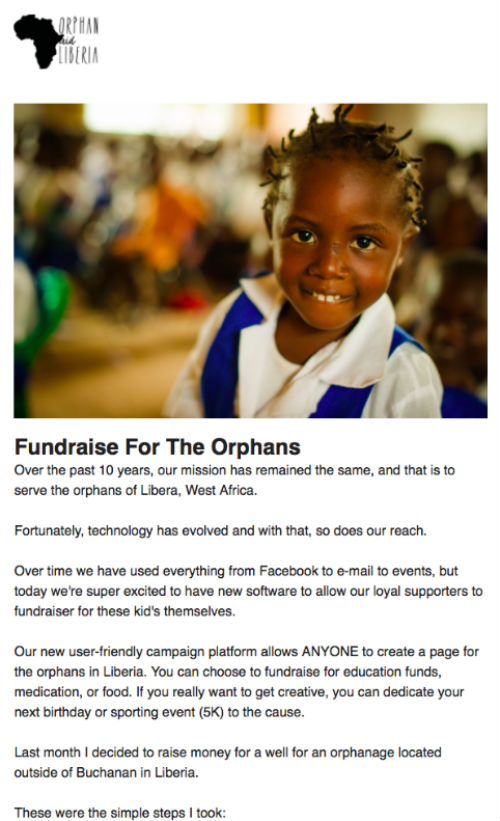
What Colleen loves about this email is that it shifts from an impact story into a mention about a new peer-to-peer campaign the organization has started. Instead of simply asking people to fundraise, they transition into a succinct “how-to” for anyone who might want to take action after reading the story. See how they list out step-by-step instructions for creating a personal fundraising page:
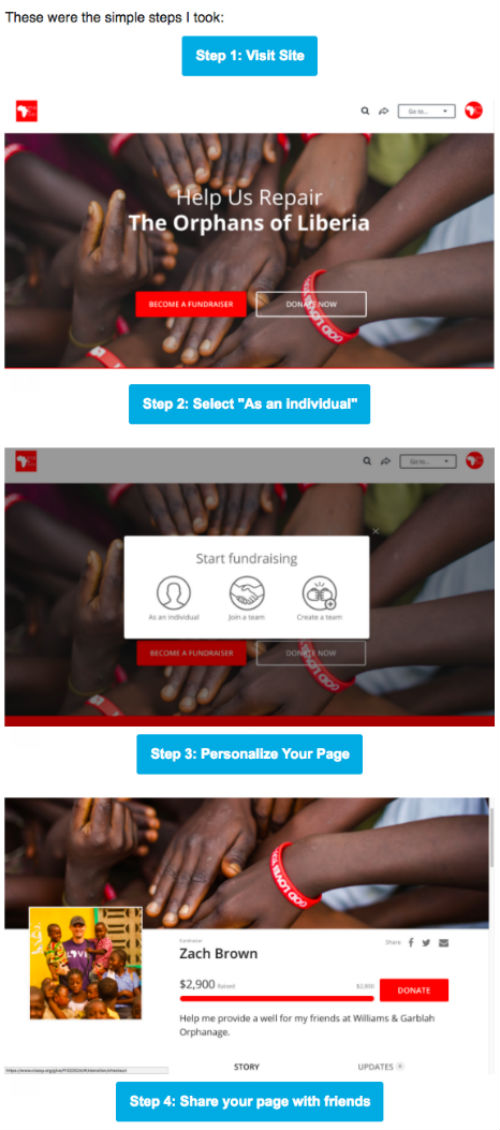
These instructions are a brilliant addition to the message. Orphan Aid Liberia is being proactive, taking a host of frequently asked questions they get about creating campaigns and putting all the answers right up front.
That, in turn, helps reduce the barrier to entry to create a page.
They also know that one of the most difficult parts of fundraising can be activating networks to donate to the fundraiser’s page once it’s created. To that end, they finish their message with a fourth step on how their fundraisers can share this page with their friends and family:
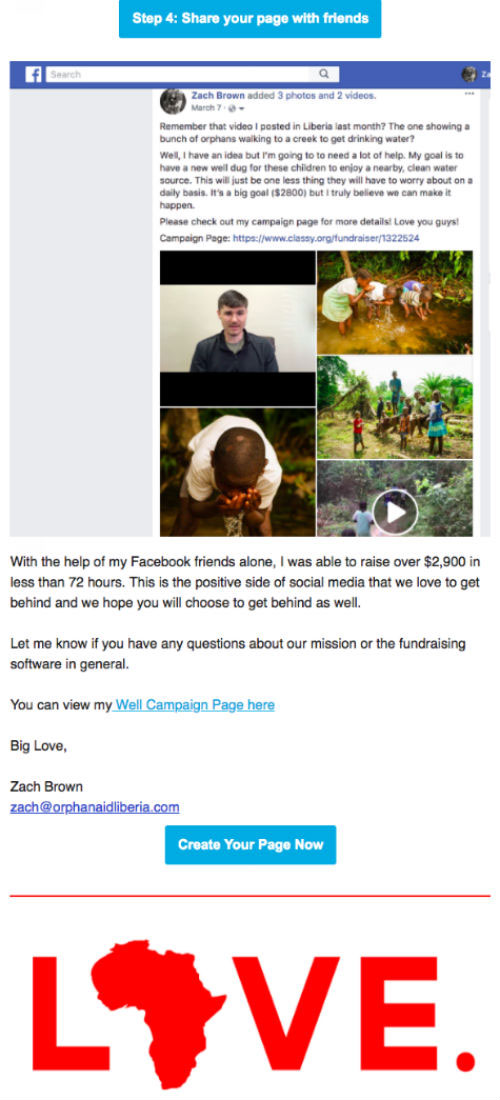
Orphan Aid Liberia’s email audience for this message is peer-to-peer fundraisers. So, they tell a story that encourages someone to fundraise, walks them through how to create a personal fundraising page, and then tells them how to share and start driving donations.
It’s not a bland walk-through. This is a journey rooted in emotion about how you, the reader of this email, can make a direct impact on the work they’re doing.
Run an Unsubscribe Campaign
While growing your email lists is important, it’s just as important to make sure your lists are filled with people who want your content. It can skew your metrics if you send weekly emails to a massive list, only to drive minimal engagement from a small group of this list.
According to Colleen, that’s why running an unsubscribe campaign can be so useful. This is where you send a message to your list of unengaged readers and give them options to stay on the list, or unsubscribe.
You can also give people the opportunity to change their settings as well. For example, maybe they only want your newsletter, your major milestone emails, or messages about your specific programs.
Jet Blue
Colleen cites an email from Jet Blue as a fun way to start this conversation. Instead of bluntly starting their email with an ask to unsubscribe or update email preferences, Jet Blue starts with humor:
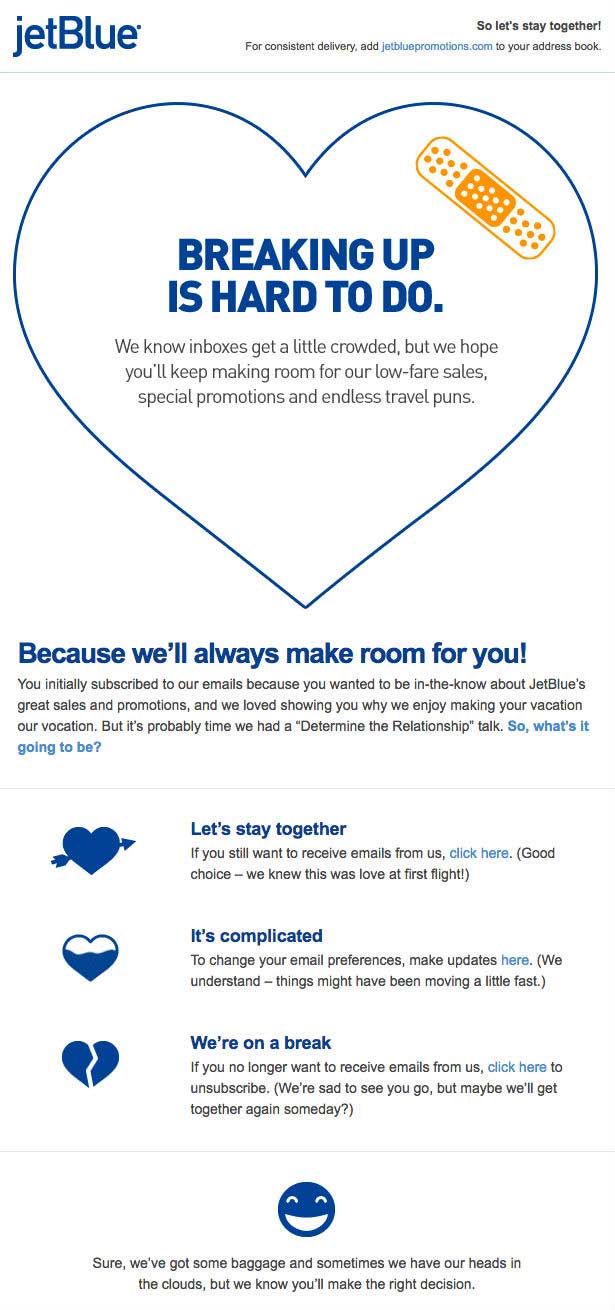
They keep the humor alive throughout the entire email with their calls to action. The parts about staying together, it’s complicated, or going on a break are fun ways to say “keep receiving emails,” “update preferences,” or “unsubscribe me from this list.”
Remember, the goal here is to refine your list so you’re sending emails to an audience that actively wants to read and engage with your content, which in turn produces success metrics that truly reflect your performance. And as you work, remember what Colleen says about an engaged list:
Use Creative Subject Lines
A subject line is the first thing people see. That makes it a tricky puzzle to fit together because you need to balance between being creative and being informative.
The wrong subject line will deter people from clicking through to your content, and thus miss out entirely on the important message. At the same time, you can’t be afraid to try out something new that might skyrocket your open rates.
When you try new subject lines, it’s a good rule of thumb to run an A/B test through your email client. That way you can know for sure which subject lines resonate, and which ones don’t.
This will help you further define who your audience is and what they like to read. Once you understand that, you can begin to push the boundaries further with humor and creativity, like Pencils of Promise does.
Pencils of Promise
Pencils of Promise knows their audience so well that when Lil Jon created a birthday campaign on their behalf, they sent an email with a subject line they knew would get readers’ attention:
“Hey it’s Lil Jon!”
This subject line immediately captures the attention of someone scrolling through their inbox. It doesn’t say much about what’s inside the email, but it’s enough to get people to click through into the content and discover more.
Once inside, people see that there’s a fully written message from Lil Jon about his recent birthday campaign experience, and why the recipient should consider donating their own birthday:
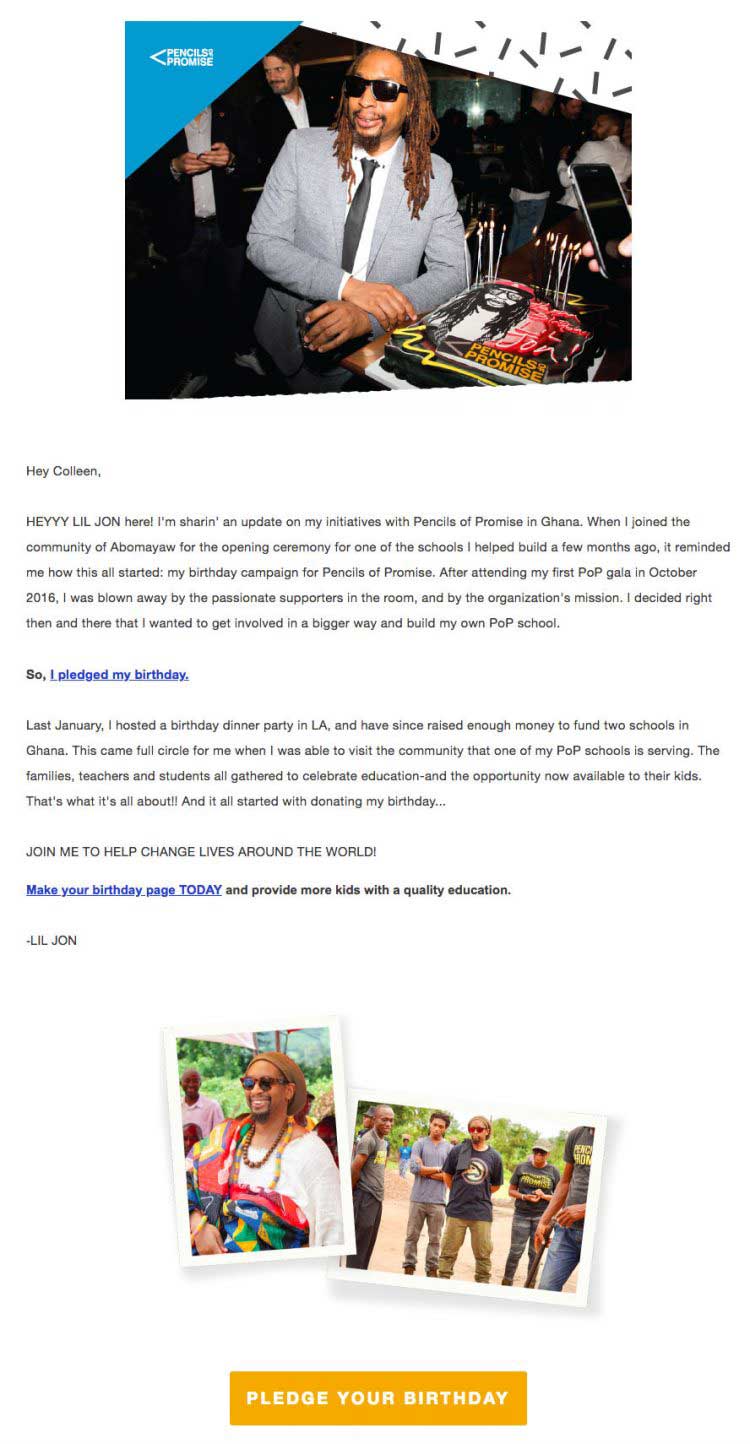
If you’re going to use a subject line like this, it’s important that you don’t let the content inside the message fall flat. That’s a recipe for disaster as people will begin to distrust your gimmicky subject lines, opting to delete them instead of reading them. Above all else, always provide value to your readers.
Finding the right combination of email elements can be challenging. As you progress in your journey don’t be afraid to take your content deeper than the surface level like Orphan Aid Liberia, keep it lighthearted like Jet Blue, or have some fun with it like Pencils of Promise.
If you want some help around your communication strategy, download the guide below for nine free email templates you can use throughout the year to increase your donor engagement.

9 Email Templates for Nonprofit Annual Communication Plan
Subscribe to the Classy Blog
Get the latest fundraising tips, trends, and ideas in your inbox.
Thank you for subscribing
You signed up for emails from Classy
Request a demo
Learn how top nonprofits use Classy to power their fundraising.



